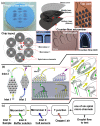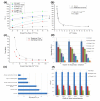A microfluidic device for continuous sensing of systemic acute toxicants in drinking water
- PMID: 24300075
- PMCID: PMC3881139
- DOI: 10.3390/ijerph10126748
A microfluidic device for continuous sensing of systemic acute toxicants in drinking water
Abstract
A bioluminescent-cell-based microfluidic device for sensing toxicants in drinking water was designed and fabricated. The system employed Vibrio fischeri cells as broad-spectrum sensors to monitor potential systemic cell toxicants in water, such as heavy metal ions and phenol. Specifically, the chip was designed for continuous detection. The chip design included two counter-flow micromixers, a T-junction droplet generator and six spiral microchannels. The cell suspension and water sample were introduced into the micromixers and dispersed into droplets in the air flow. This guaranteed sufficient oxygen supply for the cell sensors. Copper (Cu2+), zinc (Zn2+), potassium dichromate and 3,5-dichlorophenol were selected as typical toxicants to validate the sensing system. Preliminary tests verified that the system was an effective screening tool for acute toxicants although it could not recognize or quantify specific toxicants. A distinct non-linear relationship was observed between the zinc ion concentration and the Relative Luminescence Units (RLU) obtained during testing. Thus, the concentration of simple toxic chemicals in water can be roughly estimated by this system. The proposed device shows great promise for an early warning system for water safety.
Figures




Similar articles
-
Monitoring Aquaculture Water Quality: Design of an Early Warning Sensor with Aliivibrio fischeri and Predictive Models.Sensors (Basel). 2018 Aug 29;18(9):2848. doi: 10.3390/s18092848. Sensors (Basel). 2018. PMID: 30158465 Free PMC article.
-
Measurement and analysis of Vibrio fischeri cell-based microfluidic device for personal health monitoring.Annu Int Conf IEEE Eng Med Biol Soc. 2013;2013:2433-6. doi: 10.1109/EMBC.2013.6610031. Annu Int Conf IEEE Eng Med Biol Soc. 2013. PMID: 24110218
-
Smartphone-assisted dual-sided capillary microfluidic device for multiplex detection of heavy metals and nutrients in drinking water.Anal Chim Acta. 2025 Jun 22;1356:344031. doi: 10.1016/j.aca.2025.344031. Epub 2025 Apr 10. Anal Chim Acta. 2025. PMID: 40288872
-
Water toxicants: a comprehension on their health concerns, detection, and remediation.Environ Sci Pollut Res Int. 2022 Aug;29(36):53934-53953. doi: 10.1007/s11356-022-20384-x. Epub 2022 May 27. Environ Sci Pollut Res Int. 2022. PMID: 35624361 Review.
-
Fast Screening Techniques for Neurotoxigenic Substances and Other Toxicants and Pollutants Based on Thermal Lensing and Microfluidic Chips.Anal Sci. 2016;32(1):23-30. doi: 10.2116/analsci.32.23. Anal Sci. 2016. PMID: 26753701 Review.
Cited by
-
A "twisted" microfluidic mixer suitable for a wide range of flow rate applications.Biomicrofluidics. 2016 Jun 27;10(3):034120. doi: 10.1063/1.4954812. eCollection 2016 May. Biomicrofluidics. 2016. PMID: 27453767 Free PMC article.
-
Optofluidic Technology for Water Quality Monitoring.Micromachines (Basel). 2018 Apr 1;9(4):158. doi: 10.3390/mi9040158. Micromachines (Basel). 2018. PMID: 30424092 Free PMC article. Review.
-
Design and experimental approach to the construction of a human signal-molecule-profiling database.Int J Environ Res Public Health. 2013 Dec 9;10(12):6887-908. doi: 10.3390/ijerph10126887. Int J Environ Res Public Health. 2013. PMID: 24351788 Free PMC article.
-
An affordable and automated imaging approach to acquire highly resolved individual data-an example of copepod growth in response to multiple stressors.PeerJ. 2019 Apr 19;7:e6776. doi: 10.7717/peerj.6776. eCollection 2019. PeerJ. 2019. PMID: 31041153 Free PMC article.
-
Monitoring Aquaculture Water Quality: Design of an Early Warning Sensor with Aliivibrio fischeri and Predictive Models.Sensors (Basel). 2018 Aug 29;18(9):2848. doi: 10.3390/s18092848. Sensors (Basel). 2018. PMID: 30158465 Free PMC article.
References
-
- Douglas I. Urban ecology and urban ecosystems: Understanding the links to human health and well-being. Curr. Opin. Environ. Sustain. 2012;4:385–392. doi: 10.1016/j.cosust.2012.07.005. - DOI
-
- Lee A., Francisque A., Najjaran H., Rodriguez M., Hoorfar M., Imran S., Sadiq R. Online monitoring of drinking water quality in a distribution network: A selection procedure for suitable water quality parameters and sensor devices. Int. J. Syst. Assur. Eng. Manag. 2012;3:323–337. doi: 10.1007/s13198-012-0133-6. - DOI
Publication types
MeSH terms
Substances
LinkOut - more resources
Full Text Sources
Other Literature Sources
Medical
Molecular Biology Databases

